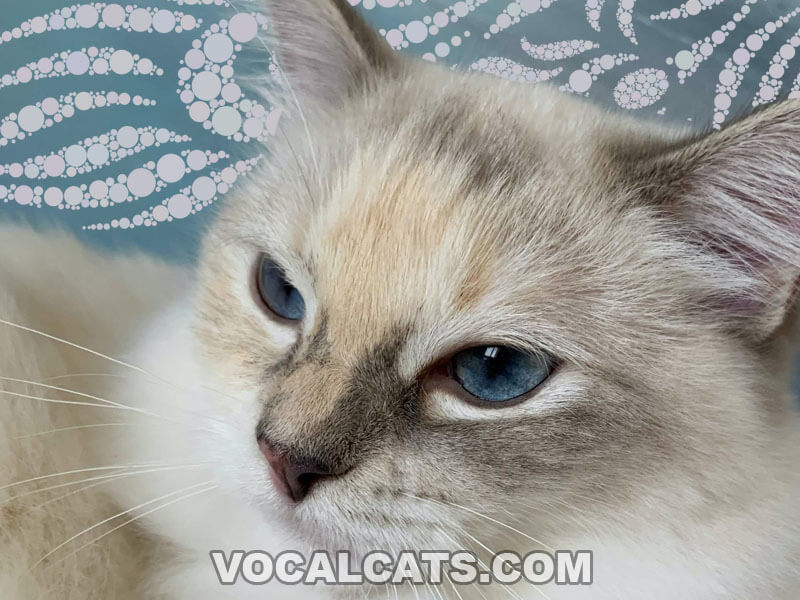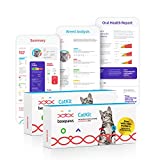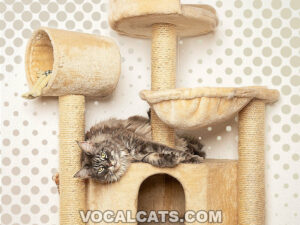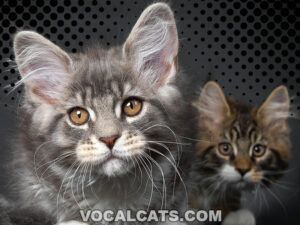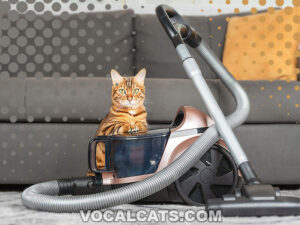Tortie Ragdoll is not a separate breed of Ragdoll but rather a Ragdoll with a different coat variation. These beautiful creatures with multi-colored points have the same personality as any Ragdoll.
Some may mistake them as being a Calico Ragdoll due to their pattern, but Tortie Ragdolls do not have the black, orange, and white patches on their body.
In this comprehensive guide, we will take a closer look at their genetics and the different coat colors and patterns possible for this variation. We will also discuss their personality, ideal living conditions, the proper way to take care of them, and how to look for the right breeder if ever you are interested in adopting one.
Contents
- Tortie Ragdoll: Breed overview
- What is a Tortie Ragdoll?
- Tortoiseshell cat vs Calico
- Tortie Ragdoll genetics
- Is the Ragdoll Tortoiseshell Cat recognized by cat registries?
- Are Tortie Ragdolls rare?
- Tortie Ragdoll Cats are always female: True or False?
- Are Tortie Ragdoll Cats born white?
- Tortoiseshell Ragdoll Cat physical appearance
- Tortie Ragdoll eye color
- Tortie Ragdoll size, height, and weight
- Tortie Ragdoll Cat coat colors and types
- Tortie Ragdoll personality
- Do Ragdoll Tortie make great family pets?
- Are Tortie Ragdolls affectionate cats?
- Tortoiseshell Ragdoll training
- Tortie Ragdoll exercise requirement
- Tortie Ragdoll Cat grooming and cleaning
- Do Tortie Ragdolls shed?
- Is Tortie Ragdoll hypoallergenic?
- Tortie Ragdoll Cat food and diet
- Tortie Ragdoll common health issues
- Tortie Ragdoll Cat lifespan
- Tortie Ragdoll breeders
- Ragdoll Tortie kitten
- Tortie Ragdoll price
- Places to find Tortie Ragdoll kittens for sale
- Finding a healthy Tortie Ragdoll for sale
- Tortie Ragdoll: Pros and Cons
- Is the Tortie Ragdoll right for me?
- Related Questions
Tortie Ragdoll: Breed overview
| Other names | Torti Ragdoll, Tortoiseshell Ragdoll |
| Size | Large |
| Weight | 16 – 20 pounds |
| Height | 9 – 11 inches |
| Coat Colors | White, Black, Seal, Chocolate, Red, Orange, Yellow, Cream, Blue, Lilac |
| Child Friendliness | High |
| Feline Friendliness | High |
| Training Difficulty | Moderate |
| Grooming Upkeep | Moderate – High |
| Exercise Needs | Low – Moderate |
| Health | Moderate |
| Lifespan | 12 – 16 years |
| Kitten Cost | $1,500 – $5,000 |
What is a Tortie Ragdoll?
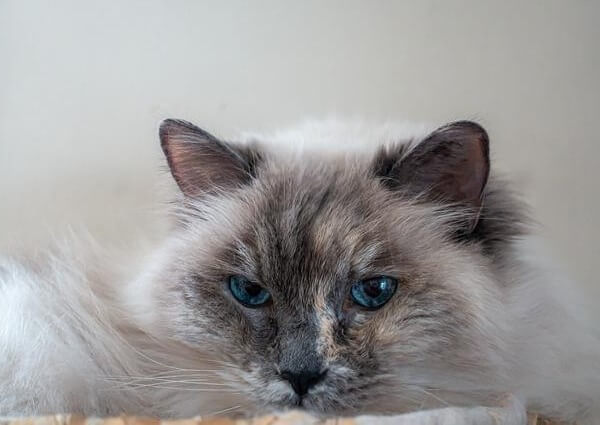
A Tortie Ragdoll or Tortoiseshell Ragdoll is a Ragdoll with a mottled marking of two colors on the head, tail, or paws.
Tortie Ragdoll Cat history
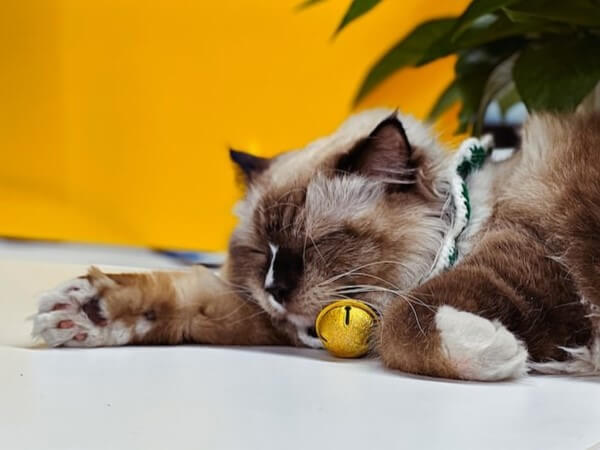
The Ragdoll was developed by Ann Baker during the 1960s in California. She crossed a white cat, named Josephine, that resembles an Angora or Persian with Burmese-like cats.
The crossbreeding produced the desired colorpoint pattern that Baker wanted. Further breeding created three (3) color patterns, namely, the colorpoint, mitted, and bicolor.
The markings also have variations of tortoiseshell and lynx that can come in all three (3) patterns and six (6) colors.
Ragdoll Cat Tortie is one of the recognized color patterns of the Ragdoll.
Tortoiseshell cat vs Calico
The main difference between Tortoiseshell cat and Calico is that Tortoiseshell cat’s coat pattern only has two colors while the Calico cat has three colors including white.
Tortie Ragdoll genetics
The colors black and orange are always attached to the X chromosome, so in order to produce a Ragdoll Tortie Cat, the Tortie Ragdoll offspring should have two X chromosomes of both orange and black.
Therefore, Tortie cats are almost always female. Only 1 in 3,000 Tortoiseshell cats are male and all of them are sterile or have health issues.
RECOMMENDED: Orange Ragdoll Cat (Complete Guide)
Is the Ragdoll Tortoiseshell Cat recognized by cat registries?
Yes, the Ragdoll Tortoiseshell Cat is recognized by cat registries such as The International Cat Association (TICA) and the Cat Fanciers’ Association (CFA). Both of them recognize the Ragdoll with a Tortoiseshell point pattern.
Are Tortie Ragdolls rare?
Since Tortie Ragdolls are mostly females, she is not as common as a Ragdoll with a colorpoint that has one color.
Tortie Ragdoll Cats are always female: True or False?
Only 1 in every 3,000 Tortie cats are male, so it is not accurate to say that all Tortie Ragdoll Cats are female. Male Tortie Cats have the rare XXY chromosome caused by a mutation making them a genetic anomaly.
However, male Ragdoll Tortie Cat, if you ever encounter one, will be sterile. Male Tortie Ragdoll will also suffer developmental issues, like brittle bones and increased body fat, as well as, behavioral problems.
Are Tortie Ragdoll Cats born white?
Yes, all traditional Ragdolls are born white, including the Tortie Ragdoll. Colorpoints will start to appear at 8 to 10 weeks of age and eventually reach their full color by age 3 or 4.
Tortoiseshell Ragdoll Cat physical appearance
Tortoiseshell Ragdoll has a long and muscular body with a wide chest and bushy tail. Their head is medium in size that sits on a short neck with a thick ruff. Their coat is single-coated consisting of long guard hairs. The plush coat makes the Ragdoll appear bigger than its size.
Tortie Ragdoll eye color
One of the distinct characteristics of the purebred Ragdoll is its blue eyes which can range from light to dark.
Tortie Ragdoll size, height, and weight
Tortie Ragdolls are large domesticated cats that are exclusively female. They will reach their full size by 4 years of age.
Here is a growth chart of the Tortie Ragdoll:
| Age | Height (Females) | Weight (Females) | Length (Females) |
| 3 months | 3-5 inches | 3-4 pounds | 8-10 inches |
| 6 months | 5-6 inches | 5-8 pounds | 10-12 inches |
| 12 months | 6-7 inches | 8-18 pounds | 13-16 inches |
| 24 months | 7-9 inches | 18-20 pounds | 17-19 inches |
Tortie Ragdoll Cat coat colors and types
Tortie Point Ragdoll will have points that have mottled patches of a dark pigment with red or cream. The Tortie points in a Tortie Point Ragdoll Cat can come in different colors, namely, seal, blue, chocolate, red, lilac, or Ragdoll Cream Tortie.
RELATED: Red Ragdoll Cat (Complete Guide)
A Tortie Point Ragdoll kitten is born completely white with their color points developing as they mature. Ragdoll Tortie point will have a light-colored body coat with dark Tortie points in their extremities depending on the pattern.
Some Tortie Ragdoll variations are not recognized by some cat registries, like the Ragdoll solid Tortie which has a darker body coat.
Mink Tortie Ragdoll
Tortie Mink Ragdoll presents with a darker shade body coat compared with traditional Ragdolls with mottled points in the extremities.
Ragdoll Tortie mitted
Tortie Mitted Ragdoll has dark points in the ear, face, and tail, but the paw points are white making her appear as if she is wearing mittens.
Tortie lynx Ragdoll
Ragdoll Tortie Lynx is also referred to as ‘Torbie’ Ragdoll. They have the distinctive tabby feature ‘M’ pencil stripes on their forehead. Ragdoll Tortie tabby can have different colors, as well as, in the three (3) patterns of bicolor, mitted, and colorpoint.
READ ALSO: Ragdoll Tabby Mix (Complete Guide)
Dilute Tortie Ragdoll
Dilute Tortie Lynx Point Ragdoll Cat have color points in the ears, nose, paws, and tail, as well as, the ‘M’ pencil pattern on the forehead. The color in the points is muted or paler compared to the traditional color points.
Ragdoll Tortie bicolor
Bicolor Tortie Ragdoll has white markings on the paws, belly, and chest, and the inverted ‘V’ white marking on the face. Tortie Bicolor Ragdoll will have dark points on the ears, tail, and outer mask. The dark points in a bi color Tortie Ragdoll exhibit the mottled pattern of dark and light.
Blue Tortie Ragdoll
A Blue Tortie Ragdoll Cat exhibits bluish-gray points in the extremities while the body coat color of a Ragdoll Blue Tortie is a soft gray tone.
Blue Tortie Ragdoll kittens are born white with the extremities darkening as they age.
DON’T MISS: Grey Ragdoll Cat (Complete Guide)
Blue Tortie bicolor Ragdoll
A Blue bicolor Tortie Ragdoll has a body coat that is a soft gray. The paws, chest and underbody of a blue Tortie bi colour Ragdoll are white.
There is also the inverted white ‘V’ marking on the face of a Ragdoll blue bicolor Tortie. The points in the ears, tail, and outer mask of a Ragdoll blue Tortie bicolor are a mottled pattern of dark and light gray.
Blue cream Tortie Ragdoll
The Blue cream Tortie Ragdoll Cat has a body coat that is bluish-white to light gray. The points in the face, nose, ears, paws and tail in a blue cream Tortie point Ragdoll are deep bluish gray speckled with cream.
You may be interested in: Cream Point Ragdoll (Complete Guide)
Blue cream Tortie bicolor Ragdoll
Blue cream Tortie bicolor Ragdoll has the same body color as the Blue cream Tortie except that they have an inverted white “V” mark on the face. The dark points are restricted to the ears, side of the face, tail, and paws.
Blue cream Tortie mitted Ragdoll
Blue cream Tortie mitted Ragdoll has similar body color and points as the Blue cream Tortie except that the paws are white in color. The white in the front paws extends up to their ankles and can extend up to the hips in the back paws.
Blue point Tortie Ragdoll
Blue Tortie point Ragdoll has a soft gray body coat, while the points in a Ragdoll blue Tortie point is a mottled deep blue-gray with light gray.
The eye color of a Ragdoll blue point Tortie ranges from ice blue to dark blue. The paw pads and nose of a blue Tortie colourpoint Ragdoll are dark gray.
READ NEXT: Blue Point Ragdoll (Complete Guide)
Blue Tortie mitted Ragdoll
Ragdoll blue Tortie mitted is similar to the Bluepoint Tortie Ragdoll with the exception of having white paws. Blue mitted Tortie Ragdoll will also have a white chin and underbelly.
Blue Tortie lynx Ragdoll
Blue Tortie lynx point Ragdoll or the Blue Tortie tabby point Ragdoll exhibits a soft gray coat, with mottled deep and light gray points. Blue Tortie tabby Ragdoll has visible ‘M’ stripes of light and gray at their forehead.
In cat registries, TICA will refer to this variation as blue “Torbie Point,” while the Cat Fanciers’ Association (CFA) will refer to them as blue Tortie point lynx Ragdoll.
DON’T MISS: Blue Lynx Ragdoll (Complete Guide)
Blue Tortie mink Ragdoll
Blue Tortie mink Ragdoll has a darker gray tone in the body compared with the traditional blue tortie Ragdoll. The points in the face, ears, paws, and tail will be dark gray.
Seal Tortie Ragdoll
Ragdoll seal Tortie has a light fawn body coat and seal brown points speckled with red or cream in the extremities. As with most Ragdolls, the female seal Tortie Ragdoll is lighter and smaller than the male.
Seal Tortie bicolor Ragdoll
Ragdoll bicolor seal Tortie also has a light fawn body coat. The points in the ears, side of face, paws, and tail in a Ragdoll seal Tortie bicolor is seal brown with mottled red or cream.
There is an inverted white ‘V’ shape on the middle of the face in a seal bicolor Tortie Ragdoll with white patches on the paws, chest, and belly.
Seal Tortie Point
Seal point Tortie Ragdoll has a cream or light yellowish tan body. The Tortie points around the face and forehead in a seal Tortie point Ragdoll have a deep brown color speckled with red or cream. In some instances, a half mask Tortie point Ragdoll with half the face in seal and the other in red or cream is possible.
Tortie Seal Point Ragdoll also has the characteristic blue eyes of most Ragdolls. Ragdoll seal Tortie point exhibits a brown nose and paw pads as well.
Seal mink Tortie Ragdoll
Seal Tortie mink Ragdoll has a brown body coat and dark brown points speckled with red and cream.
Seal Tortie Lynx Ragdoll
Seal Tortie Lynx point Ragdoll has a light fawn body coat with seal brown points speckled with red or cream. The striped ‘M’ pattern is visible on the forehead.
Seal Tortie mitted Ragdoll
Ragdoll seal Tortie mitted has a light fawn body coat. The points in the ears, face, and tail are seal brown mottled with red or cream. The paws of a seal mitted Tortie Ragdoll however are white.
You may also like: Seal Mitted Ragdoll (Complete Guide)
Chocolate Tortie Ragdoll
Chocolate Tortie Ragdoll Cat has an ivory body coat with milkish brown points mottled with red or cream. They can be present in all three (3) coat variations.
Chocolate Tortie Point
Chocolate Tortie point Ragdoll exhibits an ivory body coat with milkish brown points mottled with red or cream in the ears, face, paws, and tail.
Chocolate Tortie mitted Ragdoll
Chocolate Tortie mitted Ragdoll is similar to Chocolate Tortie Point except for their paws and chin are white with a belly stripe.
ALSO READ: Chocolate Pointed Ragdoll (Complete Guide)
Lilac Tortie Ragdoll
This is a dilute version of the Chocolate Tortie Ragdoll. Lilac Tortie Ragdoll kittens are born white but will develop light gray points mottled with pale cream as they grow older. Their body coat is glacial white with pink noses and paw pads.
Lilac Tortie bicolor Ragdoll
This color variation has a white inverted ‘V’ shape on the middle of the face.
Lilac Tortie mitted Ragdoll
Lilac Tortie mitted Ragdoll presents with a white coat with light gray points in the ears, face, and tail mottled with pale cream. Paws are colored white.
Lilac Tortie point Ragdoll
Lilac Tortie point Ragdoll presents with a white coat and light gray points speckled with light cream.
Black Tortie Ragdoll
Black Tortie Ragdoll has a solid black body coat with points that are mottled with red or cream. Unfortunately, they are not recognized by cat registries because of their color.
CHECK OUT: Black Ragdoll Cat (Complete Guide)
Tortie Ragdoll personality
Tortie Ragdolls have super friendly personalities and are playful. These gentle giants of the cat world love to meet new people and do not demonstrate even the slightest tinge of aggression.
Do Ragdoll Tortie make great family pets?
Yes, a Ragdoll Tortie makes for a great family pet. Tortie Ragdolls are very gentle, good-natured, and submissive cats that have no problem mingling with other pets. A Ragdoll Tortie is an awesome feline companion for kids because of her patience and love for playtime.
Are Tortie Ragdolls affectionate cats?
Yes, Tortie Ragdolls are super affectionate. One way they show their affection is by following their owners around the house. Also, Tortie Ragdolls love to lie down beside their human families, most of the time begging to be rubbed under the chin or behind the ears.
Tortoiseshell Ragdoll training
A Tortoiseshell Ragdoll is fairly easy to train. As soon as you bring home your fuzzy friend, begin litter training, leash training, as well as obedience training using positive reinforcement.
Tortie Ragdoll exercise requirement
Compared with other cat breeds, a Tortie Ragdoll is not as adventurous. A 20-minute light exercise each day is good enough.
Tortie Ragdoll Cat grooming and cleaning
A Tortie Ragdoll has gloriously long and soft fur. To keep her fur mat-free and glossy, frequent brushing is required. Always start brushing the part of her body where mats would likely form such as her tummy.
It’s best to use either a slicker brush or a de-shedding tool.
A Tortie Ragdoll can be given a bath once a month using shampoo with a gentle formula. Brush her teeth with an enzymatic toothpaste to reduce tartar buildup.
And even if a Tortie Ragdoll is not a heavy scratcher, still, it’s essential to maintain a healthy length of her claws by using a nail clipper specifically for cats.
Here’s a table to guide you when it comes to grooming your Tortie Ragdoll.
| Grooming Needs | Grooming Frequency |
| Hair Brushing | 3 – 4x weekly. |
| Nail Trimming | As needed. |
| Teeth Brushing | 2 -3x weekly. |
| Bathing | Once a month. |
| Eye Care | Check weekly. |
| Ear Care | Check weekly. |
Do Tortie Ragdolls shed?
Yes, Tortie Ragdolls do shed, but not excessively. Like all cats, they go through natural hair growth and shedding cycles.
However, their shedding is generally moderate and not excessive. They shed throughout the year and shed more during the spring and fall. This is when they transition from their winter to summer coats and vice versa.
During these two seasons, regular grooming can help reduce loose fur.
In addition to regular grooming, regularly vacuuming can also help. We advise feline owners to invest in a durable vacuum cleaner with a HEPA filter because it’s designed to trap small particles like cat fur, dander, and dust mites, dust from the air, carpet, hardwood floor, and other surfaces.
By vacuuming regularly during the changing seasons, it helps maintain cleanliness and reduce allergens in your home.
RELATED: Do Ragdoll Cats Shed? 7 Ways To Shed Less!
Is Tortie Ragdoll hypoallergenic?
No, Tortie Ragdoll is not hypoallergenic. Aside from her fur, allergies are triggered by her saliva which contains the FelD1 protein that causes allergic reactions in sensitive people.
If you or anyone in your family has feline allergies, placing a few air purifiers with HEPA filters throughout your home can make a huge difference.
That’s because the air purifiers with HEPA filter can help trap allergens, dust, fur, germs, mold, dust mites, and pet dander from the air.
RECOMMENDED: Are Ragdoll Cats Hypoallergenic?
Tortie Ragdoll Cat food and diet
The best food for a Tortie Ragdoll is canned cat food which is high in water content. Ideally, the cat food must contain 60% protein, 5% carbohydrates, and 30% fat.
Don’t miss: Can Cats Eat Graham Crackers?
Tortie Ragdoll common health issues
Taking care of your Tortie Ragdoll’s health should be your primary goal. If you want to know what health issues your Tortie Ragdoll is most susceptible to, we highly recommend using an at-home cat DNA testing kit.
This cat DNA testing kit not only provides you the specific breed of your cat, but also invaluable insights into your furry friend’s potential health conditions.
Below, we’ve listed three (3) common health issues among Ragdolls, and if you see any signs of illness, take her to the veterinarian as soon as possible for evaluation.
1. Blood Clots
A Tortie Ragdoll is prone to blood clotting in the arteries. The symptoms you need to watch out for are loss of appetite and breathing difficulty.
2. Polycystic Kidney Disease or PKD
This is caused by a defective gene present among Ragdolls. At birth, some affected kittens may be are born with tiny cysts in the kidneys that eventually grow bigger as they age.
3. Cryptococcosis
This is caused by a fungus that was passed through a cat’s nose and will spread to the vital organs. The signs are weight loss and sneezing.
Tortie Ragdoll Cat lifespan
The average life expectancy of Tortie Ragdoll is 12 to 16 years.
Tortie Ragdoll breeders
You may be asking ‘how do you get a Tortie Ragdoll?’ Our only response to that question is to get your kitten from a breeder that is ethical and responsible. Here are the qualities to look for:
- Ethical cat breeders do not sell their kittens in pet stores.
- Ethical breeders will only turn over the kittens to their new families when they are at least 3 months old.
- Ethical breeders have all the medical records of the parents and the kittens available.
Ragdoll Tortie kitten
Before buying a Tortie Ragdoll kitten, it is a good idea to purchase all the essentials the Tortie Ragdoll kittens will need including the following:
- Food and water bowls.
- Bed.
- Litter box.
- Cat toys.
- Collar and leash.
- Cat carrier.
- Grooming tools.
Tortie Ragdoll price
The average price of a Tortie Ragdoll kitten is $1,500 to 2,500. But the show-quality Tortie Ragdoll kittens are more expensive, ranging from $3,500 to $5,000.
Places to find Tortie Ragdoll kittens for sale
We reviewed two (2) breeders and found them to be responsible and can be trusted to get your Tortie Ragdoll kitten from.
Julie’s Ragdoll Kittens (juliesragdollkittens.com/available_Kittens.html) is from Northern California and all the Ragdoll kittens come with a one year guarantee against genetic defects.
Starliterags (starliterags.net/available-kittens) is a cattery located in central Wisconsin. They’ve been breeding Ragdoll cats since 1992. The price of the Ragdoll kittens are as low as $1,800 and can be as high as $2,400.
Finding a healthy Tortie Ragdoll for sale
If you would rather get an adult or a retired Tortie Ragdoll, you can try contacting these two (2) breeders:
Mountain Hollow Ragdolls (mountainhollowragdolls.com.au/retirees) is located in Yetholme, New South Wales, Australia and they have many retired adult Tortie Ragdolls.
You can also try Lions Royale Ragdoll Cats (lionsroyale.com/lionsroyale-ragdoll-cats-home) which is located in Ontario, Canada. They have retired breeding cats for sale.
Tortie Ragdoll: Pros and Cons
To learn more about what you can expect if you bring home a Tortie Ragdoll, here are the good and the not-so-good traits of a Tortie Ragdoll.
| Pros | Cons |
| Great family pet. | Not hypoallergenic. |
| Can co-exist peacefully with other pets. | Cannot tolerate being alone. |
| Does not mind being held. | Prone to obesity. |
| Not overly active. | Requires constant brushing. |
| Does not scratch a lot. | Due to her trusting nature, she can’t be allowed to roam freely outside without a human companion. |
| Have a beautiful silky and soft fur. | Prone to gene-related health issues. |
Is the Tortie Ragdoll right for me?
A Tortie Ragdoll is an amiable cat that gets along well with everyone. The only issue is that a Tortie Ragdoll is not hypoallergenic, so if you suffer from respiratory problems or are sensitive to feline allergens, it’s a good idea to look for hypoallergenic cat breeds.
Related Questions
Yes, you can get a Tortie Ragdoll, but be sure to get one from a responsible, ethical, and reputable cat breeder. Tortie Ragdolls are like any other Ragdoll cat except they have a mottled marking of two colors on their head, tail, or paws. When getting your Tortie Ragdoll from the breeder, ask for the medical records of the kitten and his parents. You should also see the cattery in person and observe the environment the Tortie Ragdoll kittens and their parents are living in.
Lilac Ragdolls are the rarest which can be described as sporting a white coat with pinkish points.
A pure Ragdoll cat has a beautiful set of blue eyes. Also, a pure Ragdoll cat is bigger in size compared to other cat breeds.
DISCLAIMER: THIS WEBSITE DOES NOT PROVIDE MEDICAL ADVICE
The information, including but not limited to, text, graphics, images and other material contained on this website are for informational purposes only. No material on this site is intended to be a substitute for professional veterinary advice, diagnosis, or treatment. Always seek the advice of your veterinarian or other qualified health care provider with any questions you may have regarding a medical condition.
Resources:
https://en.wikipedia.org/wiki/Ragdoll
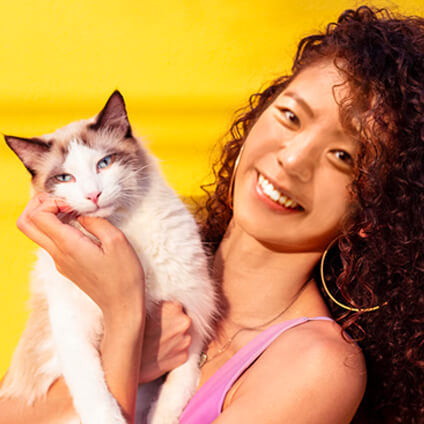
With over five years of specialized experience as an animal writer, my expertise lies in cat nutrition, health, behavior, grooming, and training. I am dedicated to delivering helpful and informative content that caters to the well-being of our feline friends. My primary goal is to empower pet owners with knowledge and ensure our feline companions thrive in health and happiness. In my free time, I love volunteering at local cat rescue centers.
